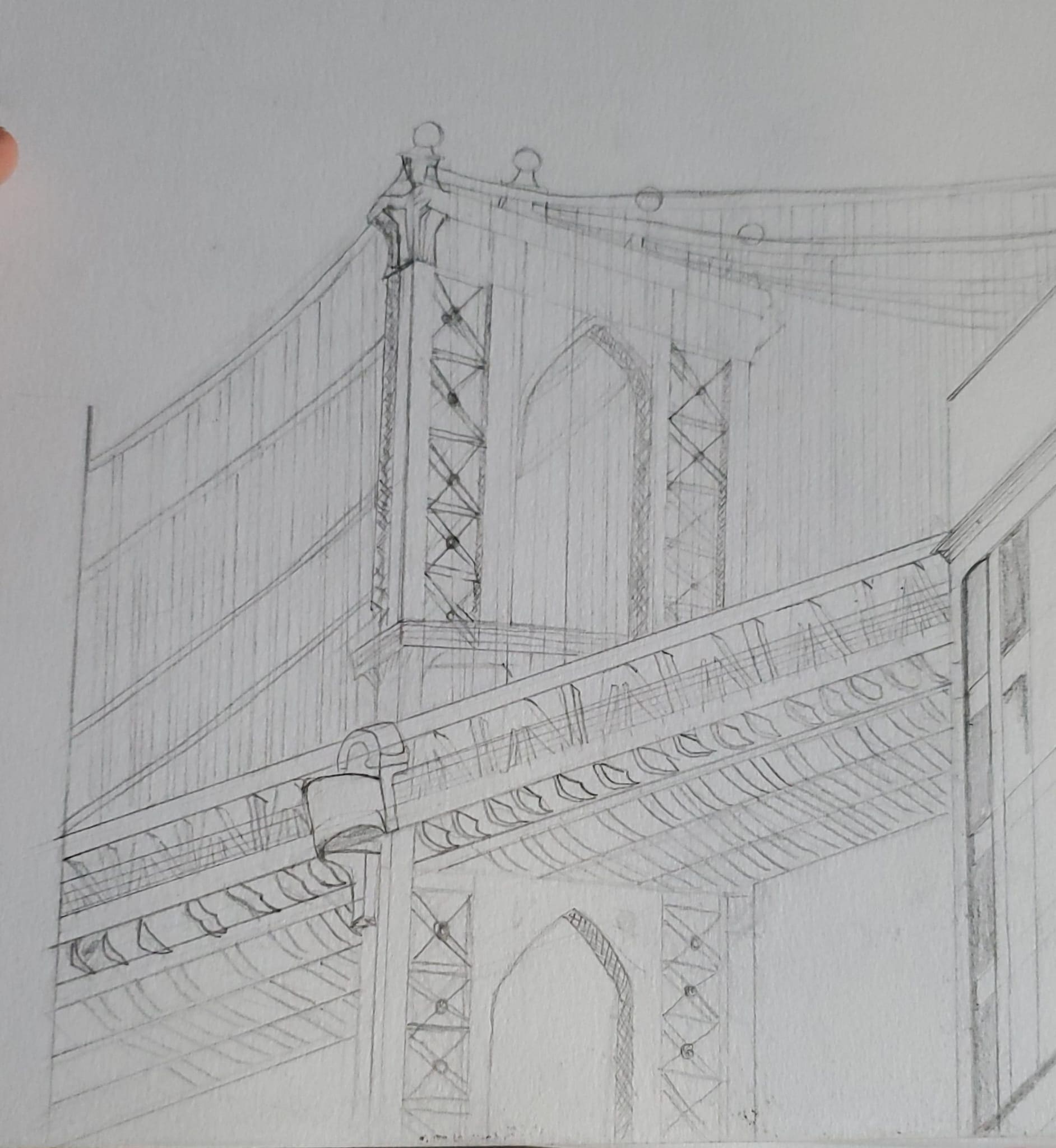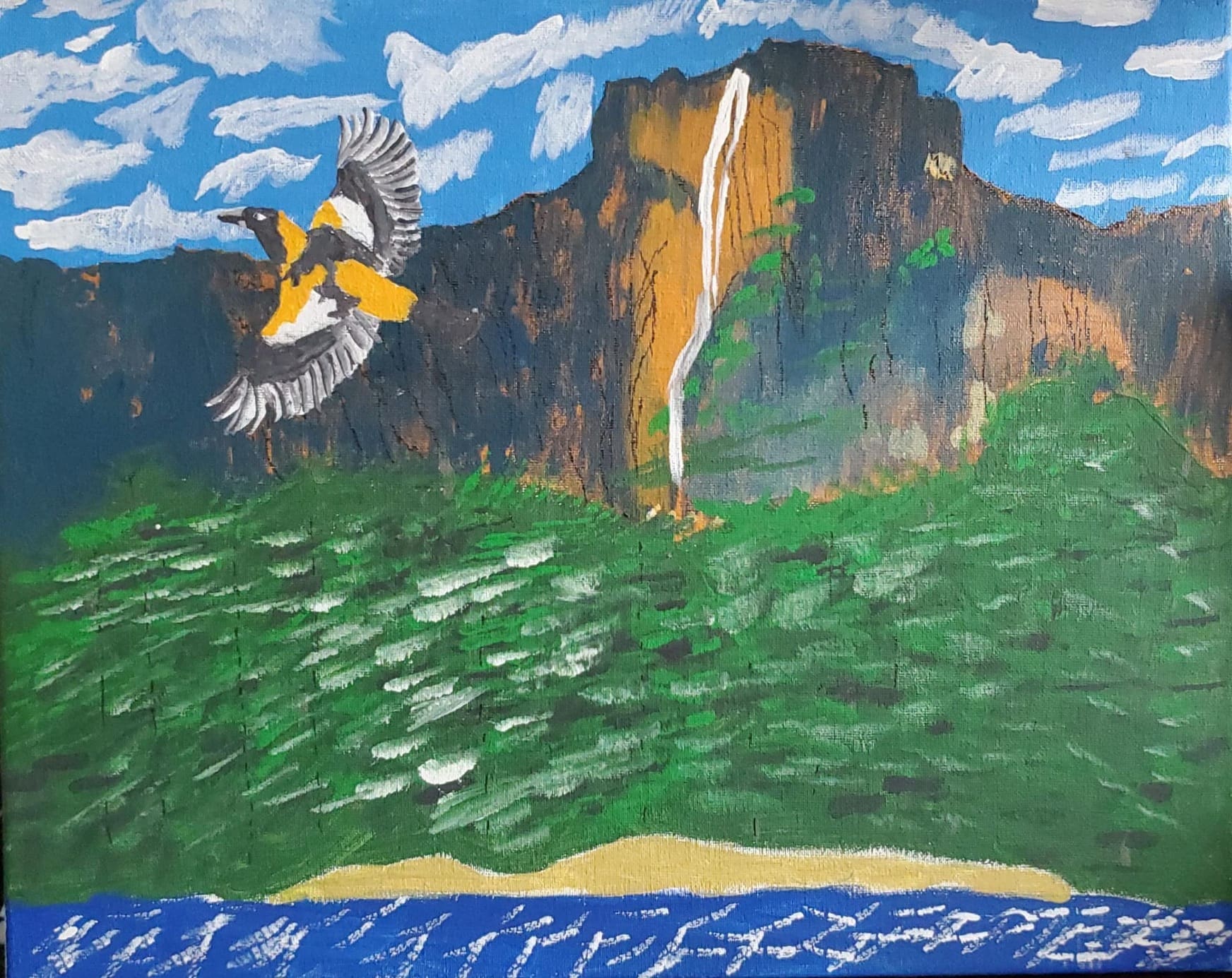Explore how the artistic journey of KIND client, Luis, to represent the iconic Salto del Angel in Venezuela through art, turned into a symbol of personal and cultural identity. Through his art, Luis not only represents the natural beauty of his home country, but also explores deeper themes of identity, cultural patrimony, and the universal search for liberty. Discover the intricate layers of emotion and meaning woven into each paint stroke, reflecting his personal growth and connection to the Venezuelan culture.
Luis' Art, Identity, and Freedom: A Journey Through Venezuela's Salto del Angel
April 16, 2024


Drawing helps me to feel a little free in that sense. It's like, as I say, my moment and my moment of peace, of tranquility. It's like I teleport to another place.
KIND: How does your work represent your cultural identity or the journey you’ve been through?
Luis: Salto del Angel, which is a place. How can I put it? It is a place… It is very representative of Venezuela and it talks about… It’s one of the biggest waterfalls in the world. So, I wanted to make a representation as such of that. So, that’s what I did the painting I did.
KIND: And have you been before?
Luis: Yeah, but I actually kind of never went inside as such, but yeah.
KIND: Got it. And this may be a little bit related to the second question of if you can share what this work of art means to you, but why Salto del Angel? I mean, Venezuela has so many beautiful things, so many representative things, why was Salto del Angel so important for you to highlight?
Luis: Because, specifically, the painting I was going to do was going to have more details. But what happened? I wanted to try to do something new, because I draw, but I don’t paint. So, it was going to be the Salto del Angel landscape with a bird, which is the representation, which is the troupial, which is the representation of the national bird of Venezuela. Along with some chains that it was being released from, but then what happened – I realized that when I was doing it yesterday, when I was ready to finish it, I realized that it was not… I mean it’s very complex as such, the drawing, because I thought, I said to myself, I have only painted, I think twice significantly, in painting form, and the rest I painted at school, I think. But the original idea was that, like drawing the troupial that was coming out, that was breaking free of the chains, of what would it mean to break free into a better place, into a free space and a space where one can be oneself, one can have the freedom of expression, One would not have fears, one would not live with the worries of what one is going to eat, what is going to happen, the worry that you are in the street and you could be robbed or any of those kinds of things.
KIND: Since you have already told us so much detail, I am curious to see the drawing. Then, if you want, you can show us the drawing so that we can.
Luis: It’s not very good because, as I said, it’s the second time I paint
KIND: Wow, how beautiful.
Luis: This is the second one, thank you.
KIND: Very beautiful. The colors really pop. If they stand out so much through the screen, I imagine that in person? I mean, wow!
Luis: Yes, the truth is that I personally… Because they told me like, ‘Well, you have to do a drawing or a painting’, and I kind of said to myself, ‘Well, let’s try something I’ve never done to see how it goes,’ because I think you also have to experiment with new things and do them to try, I think.
KIND: And what materials did you use for the painting?
Luis: What I used was acrylic paints, obviously the canvas, and creativity.
KIND: I think you answered what we had in mind for the second question. So, following up on the third, how does art help you express your emotions or experiences that may be difficult to put into words?
Luis: That question is very… Even though I’ve been kind of thinking about what I was going to say, it’s still a little…. Because specifically it’s what you can’t talk about, you convey it in the painting. But I feel like that’s like something that, so to speak, something that de-stresses, something that frees me, so to speak, from everything around. And the only thing I think about is painting at that moment and nothing else. It’s something like I’m focused on what I like and what I’m passionate about. And it’s like a little moment of not thinking about anything else, but focusing on my own thoughts and letting them flow into the drawing. De-stressing myself and if I have some doubt or if I have a little anger or I don’t know, sadness or whatever emotion I feel, I can transmit it to the paper or, specifically, now on this canvas.
KIND: And at what age did you start drawing and painting?
Luis: I started drawing as long as I can remember, literally, as long as I can remember. Normally, I already, I mean, I kind of already had that [interest for drawing and painting] since I was little. But normally, I don’t know if you’d like to see, I don’t draw. I don’t know if you can see it…
KIND: Very nice. Like a sketch?
Luis: Exactly. Those are usually the things I draw.
KIND: And the sketches in your mind, what comes to your mind at that moment and when you draw it?
Luis: There are some, at least my first sketches, they were really emotional sketches, because they were my first. When I arrived, they were like done, to de-stress, because from the moment I came, I was like, ‘Wow, what is this? Is this something new?’ But besides that, it’s more, like you said, the new ones are done more like: ‘I have nothing to do and I paint’. Or sometimes, so to speak… Believe it or not, I feel that also when I draw better, or at least when I make a self-portrait, I feel like a self-love towards myself. I don’t know if that makes sense, but at least I feel that. At least when I make drawings, I felt as if I was giving myself a hug. It’s as if, ‘Ah, yes.’ do you understand?
KIND: How nice. And is there a specific message or theme that you would like to convey through your artwork or to other people in the world?
Luis: If I had the opportunity, for now I think that… Yeah… For now. For the moment the topic itself that I could talk about would be more like a… I forgot.
KIND: No problem. If you want we can take up the question again or if you want to think about it more, no problem.
Luis: That question I forgot and never noticed it [from the questions received ahead of time]. For now, what I would like people to see from other countries, the beauty and the culture and everything, so to speak, of Venezuela, so that despite the fact that unfortunately they are going through moments of difficulty, is in a moment of crisis, they can still see the beauty and how beautiful it is [Venezuela].
KIND: And in what way has art served you as a form of therapy?
Luis: The truth is that there are times, as I told you in the beginning, when I feel frustrated or, for example, when I feel sad or I just feel something that I don’t… Like the question, when you asked me how art helps me to express emotions or experiences, it’s like those things that I can’t talk about, that I can’t…. I mean, it’s not that I can’t, but it’s like I feel a little tight – drawing helps me to feel a little free in that sense. It’s like, as I say, my moment and my moment of peace, of tranquility. It’s like I teleport to another place.
KIND: And where would you like to take your art? I mean, what precisely would you like to do with your talents? Is it something that you focus on, let’s say, in an area professionally that you would like to do as a profession at some point? Or is it something else that you do, as you say, to de-stress, as a hobby? How far do you want to go with your art?
Luis: The truth is that I have several things in my mind, but I would think at some point to take my talent to something professional, if I have thought about it. And I don’t know, maybe an exhibition or something like that.
KIND: I know he shared with us on one occasion that he wanted to be a computer design designer, like graphic design, how they call it, that he wanted to do. Could you share more about that, Luis? Your interest in that and what you aspire to do with that?
Luis: I originally wanted to be a digital animator. But I don’t know, it’s a bit complicated. But now, so as to say, what I would like to do now at present is a graphic designer. It really caught my attention and I think it’s something that carries It’s something that I would like to do more of. Or if not, then it’s like, I think it’s something that would help me improve my talents.
KIND: And you are currently studying or working? Both?
Luis: I graduated last year. And now I’m waiting. I want to go to college, but I’m waiting for the Work Permit and all that. But by the time I get the Work Permit, I think that when I can, I will enroll in a college.
KIND: So, then, thank you for showing us your work.
